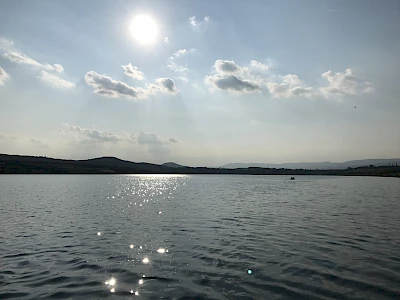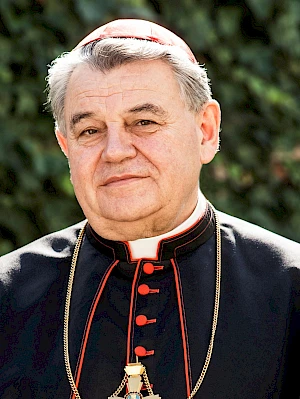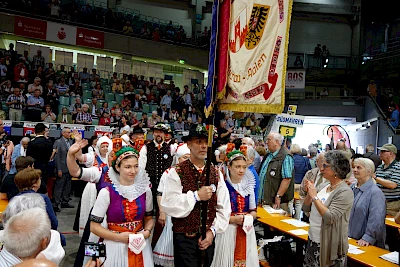Derweil in Tschechien... 45/25
21.11.2025
Schluckenauer Zipfel faces months of road closures
People in Schluckenauer Zipfel will have to prepare for restrictions on the most important road link to the south in the coming year. According to plans by the ŘSD State Road and Motorway Directorate, the state road I/9 will be completely closed between Nová huť and Svor from March 1, 2026 until October 31. The reason for this is the construction of a new bypass around the village of Svor to divert traffic away from the village. Until now, the I/9 has run right through the middle. In Svor, the I/9 meets the state road I/13, which has been widened to four lanes there in recent years.
The project to build a bypass around Svor has been planned for some time. However, it has only now become known that the Schluckenauer Zipfel will be deprived of its only state road towards the interior of the country for eight months. The detour is planned over a large area via Chříbská and Česká Kamenice, starting in Jiřetín pod Jedlovou. However, the mayors of the municipalities in the Šluknov region are up in arms against this. The towns of Varnsdorf, Krásná Lípa and Rumburk in particular are showing a lack of understanding. Not only do thousands of people use the I/9 to get to work and training every day, the route is also used by emergency services for trips to the hospital in Česká Lípa. There are also regular bus services to Prague. The detour route, on the other hand, is already well utilized.
The mayors are calling for a different technical solution to allow traffic to continue across the I/9 at least alternately in one lane or in two lanes via a temporary bridge. At the very least, the duration of the closure should be significantly shortened. The Ústí district has also joined the demands. The construction project itself is located in the Liberec district. The investor, the ŘSD State Road and Motorway Directorate, has referred to the difficult profile in the vicinity of the road construction site. A full closure is unavoidable.
Municipalities get land at the Milada open-cast mining lake

At one of its last meetings, the current Czech government decided to transfer land at the Milada open-cast mining lake near Ústí nad Labem (Aussig) free of charge. The decision is seen as the first and most important step in the further development of this already popular recreational area. Until now, the land has been owned by the state and managed by the state-owned company Diamo, which looks after former mining areas. In future, the land will be transferred to the Milada Lake Voluntary Association of Municipalities (Dobrovolný svazek obcí Jezero Milada). In addition to Ústí, this includes the municipalities of Chabařovice, Trmice and Řehlovice. A total of 378 plots of land with an area of 8.2 million square meters are involved.
There is only one step left to realize the plans for a recreational area around Lake Milada: the write-off of the lignite reserves under the area around the lake. According to estimates, this amounts to 128 million tons of coal. Although the lake has been open for tourist use for over ten years, the state could theoretically still access the lignite reserves at any time, which would prevent reliable planning. The coal deposits must be written off by the mining authority in consultation with the Ministry of the Environment. This is expected to take place in the course of 2026.
There is already infrastructure for leisure and recreation on the lakeshore. Diamo recently awarded ten-year leases to operators of boat and SUP rentals, snack bars and bars. The long-term contracts will remain valid even after the municipal association takes over the land. With the new ownership structure, however, even more far-reaching projects are possible. These include the "Wild Milada" project (see "Meanwhile in the Czech Republic ... 20/25). The Ústí Zoo, the city of Ústí and the Ústí district are planning a 700-hectare reserve for wild animals from Asia, a bird sanctuary and prehistoric animals such as bison, Przewalski's horses and other offspring in the area of Lake Milada.
North Bohemia's heating industry plans to phase out coal by 2030
The Czech Republic is speeding up its coal phase-out. In North Bohemia, the heart of lignite mining to date, the supply of district heating will no longer be based on lignite by 2030, according to the main heating supplier ČEZ. Coal will be replaced by natural gas and biomass in future. In the long term, the majority state-owned energy company ČEZ is also relying on heat supply from small modular nuclear reactors, hydrogen and waste incineration.
The first steps have already been taken. In June, for example, a new gas boiler went into operation in Prunéřov near Chomutov, which serves as an alternative heat source to the existing coal-fired power plant. In future, it will supply heat to the nearby town of Kadaň, which currently obtains its district heating from the Tušimice coal-fired power plant. To this end, ČEZ is building a 5.7-kilometer-long heat pipeline from Prunéřov to Kadaň. A biomass boiler and other gas boilers are also to be built in Prunéřov. They will supply heat from the 2028/29 heating season.
Prunéřov was once home to the largest coal-fired power plants in the Czech Republic. The Prunéřov I power plant was considered one of the biggest polluters in Europe and was taken off the grid in June 2020.
ČEZ also built five new gas boilers and one kilometer of heating pipeline in Ústí nad Labem in cooperation with the city. This secured district heating for 3,000 households.
ČEZ's other plans on the road to phasing out coal include the construction of a combined heat and power plant in Prunéřov, a small modular reactor in Tušimice and a gas-steam combined cycle power plant in Trmice near Ústí. ČEZ has announced investments of over 4 billion euros in the transformation of the energy industry in the Ústí region alone by 2030.
Czech Republic says goodbye to Cardinal Duka

Last weekend, the Czech Republic bid farewell to the long-serving Archbishop of Prague and 'Cardinal Dominik Duka with a mass in Prague's St. Vitus Cathedral on Hradčany Hill. Duka died on November 4 at the age of 82. He was Archbishop of Prague for more than 12 years until 2022.
The commemoration took place in the presence of the current President Petr Pavel and his two predecessors Václav Klaus and Miloš Zeman. The Requiem in B flat minor by Antonín Dvořák was performed. Dignitaries from other religions and faith communities also paid their last respects to the long-serving archbishop. Duka's body was laid to rest in the crypt of the archbishops in St. Vitus Cathedral. The mortal remains of his predecessors František Tomášek and Miloslav Vlk already rest there.
Duka worked as a priest illegally before 1989 and was imprisoned for two years. He led the Dominican Order in Czechoslovakia from 1986. In 1998, he was appointed Bishop of Hradec Králové (Königgrätz) until he was appointed the new Archbishop of Prague in 2010. He was succeeded in 2022 by the then Bishop of Olomouc, Jan Graubner.
After the death of his predecessor Miloslav Vlk, hopes rested on Duka to continue Vlk's course of opening up. However, these were disappointed time and time again. Duka acted as a conservative guardian of Catholic tradition. One of the highlights of his time in office was the re-erection and consecration of the Marian Column on Old Town Square.
Sudeten German Day 2026 in the Czech Republic for the first time

Next year, the Sudeten German Landsmannschaft will be holding its Sudeten German Day in its old homeland of the Czech Republic for the first time. It traditionally takes place at Whitsun, next year from May 22 to 25, this time in the Moravian metropolis of Brno (Brünn). It is no coincidence that Brno was chosen. Years ago, the second largest city in the Czech Republic was the first to officially commemorate the victims of the expulsion of the German population. For ten years, the most important symbol has been the March of Reconciliation, which always takes place in June in the opposite direction and commemorates the 1945 death march from the Austrian border to Brno.
The decision to choose Brno follows an invitation from the "Meeting Brno" association, which organizes the Reconciliation March, which was extended at the last Sudeten German Day in Regensburg this year.
Premiere for steamboat trips during Advent

For the first time this year, there will be Advent steamboat trips on the Elbe between Bad Schandau and Roudnice nad Labem (Raudnitz). From November 27, the Labská plavební společnost shipping company will be setting off on regular river trips on its historic paddle steamer "Labe" (Elbe) on behalf of the Ústí district. The steamboat trips take place every Thursday to Sunday. The last trip is on December 21.
As the trips are ordered by the Ústí Region, a discounted ticket from the Doprava Ústeckého kraje transport company is valid on all routes and can be purchased via the "DÚKapka" app, which is also available in German. According to the schedule, the steamer runs between Ústí nad Labem and Litoměřice (Leitmeritz) on Thursdays and Fridays, from Ústí to Bad Schandau and back on Saturdays and from Ústí nad Roudnice nad Labem on Sundays.
The Ústí district offers the rental of saloons to retirement homes and school classes. At the same time, with this first-time offer, the district would also like to compensate for the many days on which no steamboat trips were possible this year due to low water levels, according to a press release. The district estimates the cost of the steamboat trips at 1.8 million crowns (75,000 euros).
If you would like to receive our weekly review regularly in your email inbox, sign up for our newsletter.
